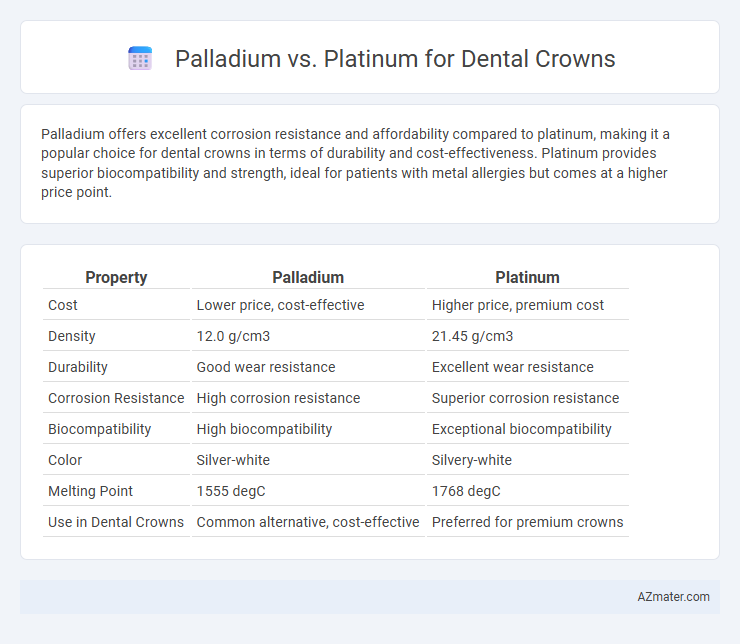Palladium offers excellent corrosion resistance and affordability compared to platinum, making it a popular choice for dental crowns in terms of durability and cost-effectiveness. Platinum provides superior biocompatibility and strength, ideal for patients with metal allergies but comes at a higher price point.
Table of Comparison
| Property | Palladium | Platinum |
|---|---|---|
| Cost | Lower price, cost-effective | Higher price, premium cost |
| Density | 12.0 g/cm3 | 21.45 g/cm3 |
| Durability | Good wear resistance | Excellent wear resistance |
| Corrosion Resistance | High corrosion resistance | Superior corrosion resistance |
| Biocompatibility | High biocompatibility | Exceptional biocompatibility |
| Color | Silver-white | Silvery-white |
| Melting Point | 1555 degC | 1768 degC |
| Use in Dental Crowns | Common alternative, cost-effective | Preferred for premium crowns |
Overview of Palladium and Platinum in Dentistry
Palladium, a dense, corrosion-resistant metal, is commonly used in dental crowns due to its affordability and biocompatibility, making it ideal for patients with metal allergies. Platinum, prized for its durability and hypoallergenic properties, offers superior strength but comes at a higher cost, often reserved for premium dental restorations. Both metals enhance crown longevity, with palladium alloys frequently combined with other metals to improve mechanical properties, while platinum's rarity ensures excellent resistance to wear and tarnish.
Composition and Properties of Palladium vs Platinum
Palladium dental crowns consist primarily of palladium mixed with other metals like silver, copper, and zinc, providing high corrosion resistance and excellent biocompatibility. Platinum crowns, composed mainly of platinum combined with metals like iridium or ruthenium, exhibit superior hardness and durability but at a higher cost and density compared to palladium alloys. Palladium alloys offer better workability and lower weight, making them preferred for dental restorations, whereas platinum alloys excel in strength and wear resistance but are less commonly used due to cost and machinability factors.
Durability and Strength Comparison
Palladium dental crowns exhibit exceptional strength and resistance to corrosion, making them highly durable for long-term use in biting and chewing. Platinum crowns offer superior hardness and wear resistance, providing enhanced durability, especially in high-stress areas of the mouth. Both metals ensure longevity, but platinum typically surpasses palladium in terms of rigidity and resistance to deformation under heavy occlusal forces.
Biocompatibility and Allergy Concerns
Palladium and platinum are both used in dental crowns for their strength and corrosion resistance, but palladium has a higher potential to cause allergic reactions compared to platinum. Platinum exhibits superior biocompatibility with minimal hypersensitivity incidences, making it a preferred choice for patients with metal allergies or sensitive tissues. Studies indicate that platinum dental alloys reduce the risk of oral mucosal irritation and promote better long-term tissue integration than palladium-based materials.
Aesthetics: Color, Shine, and Suitability
Platinum crowns exhibit a naturally white and lustrous shine, closely matching the color of natural teeth, making them highly suitable for visible dental restorations that prioritize aesthetics. Palladium crowns, while offering good durability, tend to have a slightly darker, grayish tint that may affect the overall appearance, especially in front teeth. The superior color stability and brightness of platinum enhance the cosmetic appeal of dental crowns, making them the preferred choice where aesthetics are paramount.
Cost Differences: Palladium vs Platinum Crowns
Palladium dental crowns typically cost significantly less than platinum crowns due to the lower market price of palladium as a precious metal. The price difference can range from 30% to 50%, making palladium crowns a more cost-effective option for dental restoration. Platinum crowns, while more expensive, offer superior durability and hypoallergenic properties, contributing to their higher price point in dental applications.
Longevity and Wear Resistance
Palladium dental crowns offer excellent longevity due to their resistance to corrosion and high wear resistance, making them durable for long-term dental restorations. Platinum crowns, while biocompatible and corrosion-resistant, generally have lower hardness compared to palladium, resulting in comparatively reduced wear resistance. Studies indicate palladium-based alloys maintain structural integrity and wear resistance over extended periods, ensuring longer-lasting dental crowns in demanding oral environments.
Clinical Performance in Dental Applications
Palladium dental crowns exhibit excellent corrosion resistance and biocompatibility, ensuring durability and minimizing allergic reactions in patients. Platinum, while highly biocompatible and corrosion-resistant, is less commonly used due to its higher cost and slightly lower hardness compared to palladium alloys. Clinical studies indicate that palladium-based crowns provide superior wear resistance and marginal integrity, making them a preferred choice in restorative dentistry for long-term clinical performance.
Maintenance and Care Requirements
Palladium dental crowns offer excellent resistance to tarnish and corrosion, requiring minimal maintenance compared to platinum crowns, which are softer and prone to scratching, necessitating more frequent professional polishing. Patients with palladium crowns benefit from routine oral hygiene practices such as brushing and flossing, while platinum crowns demand careful handling to preserve their surface integrity and avoid premature wear. Both metals require regular dental check-ups to monitor crown condition and ensure the surrounding gum tissue remains healthy.
Choosing the Right Material for Your Dental Crown
Palladium and platinum both offer durability and biocompatibility for dental crowns, but palladium's higher corrosion resistance and cost-effectiveness make it a preferred choice in many dental restorations. Platinum, though more expensive, provides superior strength and a natural white luster that enhances the crown's aesthetic appeal, especially in visible areas. Selecting between palladium and platinum depends on factors such as budget, metal sensitivity, and the crown's location in the mouth for optimal performance and longevity.

Infographic: Palladium vs Platinum for Dental Crown
 azmater.com
azmater.com